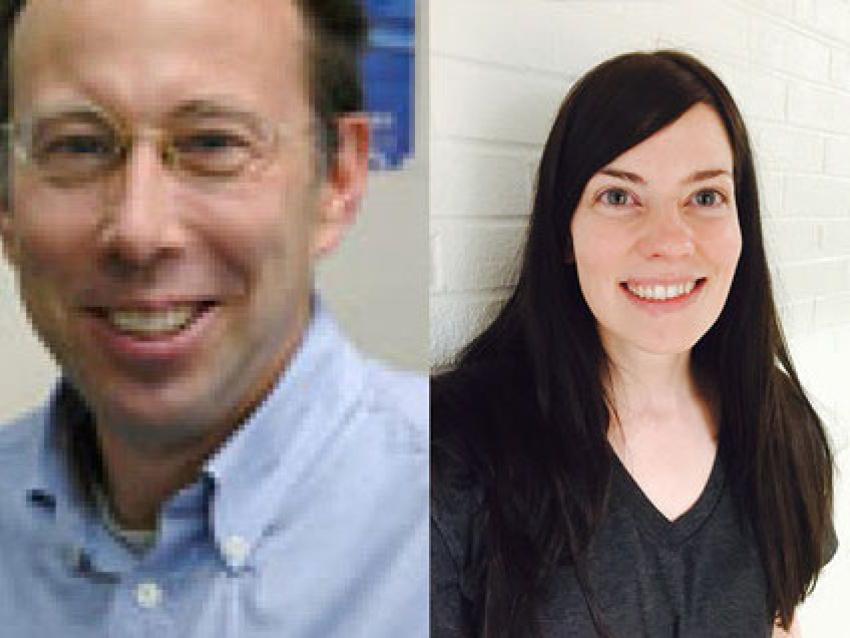
College of Nursing PhD Student and Alum Engage Kentucky High Schoolers in Collaborative Health Project
By Mallory Powell
For most high school students, physics, health, communication and technology are the subjects of separate classes. In Lewis County, Kentucky, however, high school freshmen are integrating these topics and skills through a collaborative, web-based project with scientists and students at the University of Kentucky.
The project is a joint venture of Sara Poeppelman, a 16-year science teacher and department chair at Lewis County High School, and Robin Cooper, Ph.D., associate professor of biology at UK. The two educators met through their work with the Partnership Initiative for Math and Science Education Reform (PIMSER). Cooper, who received his BSN from UK and has a passion for public health, is demonstrably committed to engaging young people in science, including establishing the Kentucky Science and Engineering Fair in association with Intel® International Science and Engineering Fair® (Intel ISEF). Poeppelman is similarly motivated to facilitate interactive and exciting science opportunities for her students.
She and Cooper devised a web-based collaboration that gets students to use social media, smart phones and iPads — all while learning the physics and consequences of obesity and cardiovascular disease. The project is supported by a community grant from the UK Center for Clinical and Translational Science, which aims to accelerate discoveries for human health and focuses specifically on health disparities in Appalachia.
“How can we reach kids in formats and ways that they’re comfortable with?” Poeppelman said.
The project involves two freshman physics classes at Lewis County High School. Led by Poeppelman and another teacher, Summer Hampton Behrendt, students are divided into groups and work through a “case study” about a fictional patient named Cindy, who is middle-aged, overweight and has high blood pressure.
Each group must build a visual model — using tubes, water and pumps — to demonstrate to Cindy the physics of what is happening within her blood vessels and why hypertension is dangerous for her health. The students then make videos to demonstrate their models and address with Cindy a holistic approach to her heath, including lifestyle changes, available medications, and possible outcomes like cardiovascular disease. The videos are uploaded to a secure online platform called Acclaim, and UK science faculty and students then provide feedback and engage the Lewis Co. students in conversation about the case.
“I thought it was interesting in to do something hands-on like that in class,” said Caleb Voiers, a Lewis County freshman who’s interested in nursing. “It was fun – it was wet and messy and out of the ordinary and stuff that you wouldn’t normally do in a physics.” (Voier's video is included at the conclusion of the article).
The project aligns with the Next Generation Science Standards, which emphasize integration of scientific fields and the use of practical applications. The Cindy Case asks students to look at a common health problem through the lens of physics principles such as force and fluid flow, and then communicate their conclusions clearly.
“It’s way more than just ‘hard science skills’. It’s communication and collaboration as much as anything else,” Poeppelman said. “And it’s strengthening our curriculum by getting kids to look at different ways that science can impact their lives, and different applications of science. Some of them thought it was hard, but that’s just the nature of science, and building some of that grit and getting kids to take on challenges is how I conduct my class. I want them to take on challenges, and I’ll help them.”
From Cooper’s perspective, the necessity of engaging young people in science is more urgent than just meeting the Next Generation Science Standards.
“If we don’t get these younger kids interested in science, we’re going to end up with a public sector that doesn’t appreciate science. The only way to reverse that is to get kids to realize that we need to be science literate to advance our state as a whole,” he said.
As part of the Cindy Case, the Lewis County students also examined state and county-level public health data from the Centers for Disease Control and Prevention. Kentucky has some of the nation’s highest rates of heart disease, stroke, cancer and diabetes, especially in the Appalachian region. The data included rates of these diseases but also statistics about income, graduation rates and education levels. The information sparked an unexpected conversation about the relationship between economic development, education, and health.
“We looked at big sets of health data, and some of the kids didn’t realize that we had so many health-related and other issues in our area. For example, one of the kids said, ‘This is awful! Do we really have that many drop-outs here?’” Poeppelman said. “We had some really good discussions about why having a good education and not moving out of Lewis County for good — but moving back to Lewis County and bringing some skills and industry — would be important to our community. The discussion was one of the unintended consequences of the project. I didn’t expect it to go there, but the kids said they saw real problems and I said, ‘Ok, well then what are you going to do about it?’”
The potential to encourage kids in their education is one of the main reasons that Sarah Martha, a doctoral student of nursing at UK, volunteers as one of the project mentors. Motivated by her own experiences a shy high school student without much access to science resources or encouragement to go to college, she sees the project as a way to give all students an equal voice, get them thinking about their future educational plans, and break down barriers and fears about college. She thinks it’s especially important to engage young women in science through mentorship with women in science careers.
“I identify with the high school students who might be hesitant in sharing information in class and talking aloud. I’m a little shy myself, so I understand. But kids are on their phones and doing social media all the time, and this gives them the opportunity to have a voice.” She said. “And I identify with the students who don’t have access, and I want them to succeed. I want them to realize that the university is not a scary place and I want to break down the barriers to college. And this is just a neat opportunity for them to interact with professors and university students. For me it goes back to the system and how we are placed within. Everyone should be granted the same opportunities, and some of us aren’t.”
Cooper and Poeppelman hope to expand the project to more classes in the future. They also plan to involve students in community health outreach through what they call “Healthy Flea” — setting up a health information booth and screenings (in collaboration with the local health department) at the popular local flea market.
